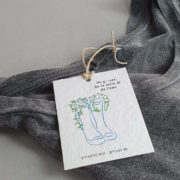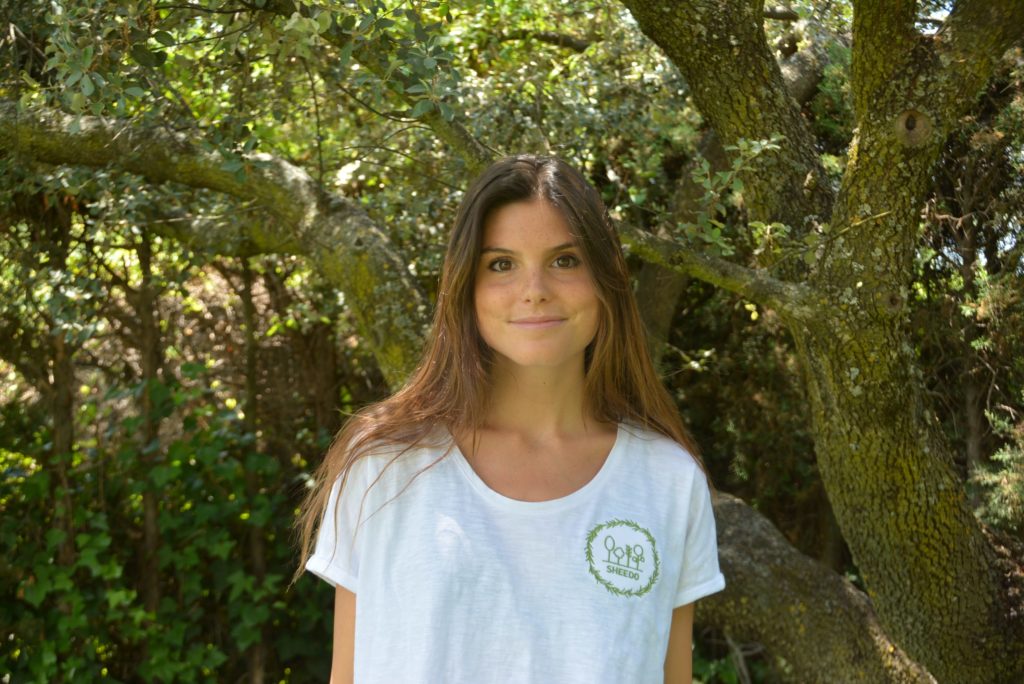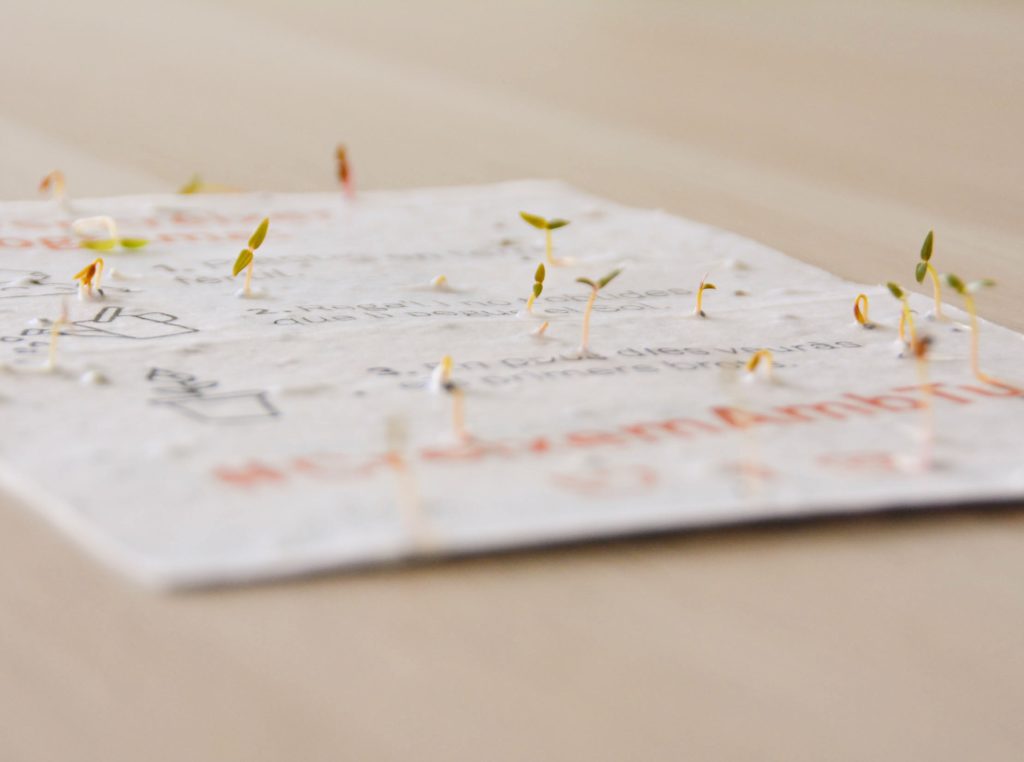Sheedo Studio are the innovators behind clothing labels you can plant

Clothing labels usually go unnoticed by consumers. Think about it. What do you, as a consumer, usually do with the label of your newly-bought garment? You probably throw it away. Imagine the amount of fashion garments that are bought everyday, hence, the amount of labels that are thrown away contributing to deforestation and the waste challenge of the textile industry.
Even so, what we probably don’t realise is the potential that a clothing label has. A
label represents what the company is selling to us and gives us, consumers, the full
picture of the product. Without labels we wouldn’t know the name, material or size of
the product we are buying. Arguably, labels are key for the development and growth
of the fashion industry.
Still, the majority of fashion companies keep using the standard ‘newly produced’
paper or plastic labels, sometimes, contradicting their own sustainable values. I must
say that in order to reach sustainable goals, in my opinion, it is key to try and be
sustainable even with the ‘small’ details, and clothing labels is definitely one of them.
But, how can these labels be sustainable?
Some companies are inspiring me to foresee what the future of fashion labelling will
be. What if your clothing label could become a tomato, a carrot, or chamomille whilst
contributing to the challenge of textile waste and deforestation?
Gala Freixa, a young Spanish entrepreneur women recognized by Forbes
Magazine’s list of ‘under 30’ with her company Sheedo Studio, has introduced to us
what could be next in the labelling industry.

Tell us about Sheedo Studio
Sheedo, the paper revolution: we replace disposable paper for one you can plant
after its use. Our paper is handcrafted and produced in a Spanish paper mill.
It is manufactured sheet by sheet using recycled cotton fibers that come from the
textile industry waste. The paper is free of toxic chemicals (we have no need of
bleaching our paper since cotton is already white) and the result is a 100%
sustainable paper.
Part of Sheedo’s paper magic is based on the fact that it is not cellulose based, so
we don’t contribute to the uncontrolled logging of trees caused by the paper industry.
But the most surprising part of our paper’s magic relies on the fact that it has seeds
in its composition! This means that once the paper is no longer of use, anyone can
plant it and grant the ‘papers second life’.
We close the consumption circle by returning to Earth the resources it has lent us
overtime. We believe our paper has a strong educational component. Using it is no more than a simple action, but it holds a strong meaning: Every person who gets a Sheedo paper is given the chance to recall their bond with nature, and understand how
difficult it is to give life to a new plant, yet how easy it is to destroy it.
We see our product as a new and revolutionary route to which substitutes
conventional paper industry practices: it is zero-waste, creates life, reconnects
people with nature and is is actually quite cool as a souvenir!
Why was Sheedo born?
Our original approach was a completely different business plan: to develop an eco
friendly shoes brand. While doing some research for these shoes possible packaging we found out about the existence of paper with seeds. This is not a revolutionary concept, it was originally used as a planting method. We had been involved with the concept while growing up: planting lentils in cotton is something quite common in Spanish primary schools.
The revolutionary part of our idea came when we transformed this cotton into paper
and developed a sustainable way to print it, making sure the seeds were preserved. We fell in love with this idea and so we focused on it, leaving aside the shoes
project.
Why do you think environmental sustainability is needed in our societies,
and why ecological marketing specifically?
Environmental sustainability is no longer a choice but a “must”: companies have to
change and adopt new behaviours and practises to ensure the preservation of our
planet. In much the same way, sustainable marketing is about doing things the right
way, striving for long-term success and company longevity.
Luckily, consumers are demanding more and more sustainable options and they
expect some environmental implications from the brands. That’s why it is so important that businesses are aware of what it takes to achieve a fully sustainable business model and be ready to commit. It takes more than just aligning the brand with the “eco trend”. There should be significant changes in their product, in their production chain and in their communication.
Tell us more about Sheedo’s plantable paper. In which way is it sustainable and how does it work to ‘plant’ a paper?
Sheedo does not only replace normal paper and avoids deforestation, but it recycles
unwanted clothes that otherwise would be ending up in landfills. Unfortunately
people’s buying habits generate 800.000 tonnes of post-consumer textile waste that
is generated worldwide each year and only a 12% of the material used for clothing
ends up being recycled. In Sheedo, for example, we gave a second life to 15 tonnes
of cotton last year.
It’s really easy to plant our paper, you can do it in three simple steps:

- Fill in a pot with soil and put the paper on top.
- Place the pot in a sunny spot and water it every day.
- Take care of it and after a week you will see the firsts sprouts of carrots,
tomatoes, chamomille, wild flowers or celosia!
In which way could a Sheedo” label be better than a current garment
label in the fashion industry?
We replace disposable tags for ones that can be planted. A Sheedo label offers a
100% sustainable buying experience and it activates an unforgettable experience to
the customer. If you are a committed clothing brand and you offer plantable seed
tags on your clothing, you are setting out your intention of practicing sustainability
within the industry.
Our approach is to help our customers fulfill their desire to become more
sustainable, it is to constantly showcase the latest developments and new materials.
We make it easy to make eco-friendly choices.
So far, do you believe your product has worked well with the current fashion
companies you are working with?
Yes, our customers are very thankful and very happy with our product. Our paper is
also often used as a greeting card that brands include in their online orders, and
where they tell the customer their story and their commitment. Transparency,
dedication, and honesty are almost a requirement for the younger generation when it
comes to what they look for in a company and Sheedo is a way of communicating
this.
How do you foresee the future of fashion labelling?
Labels are getting more and more important in the fashion industry. We as
consumers show an increasing awareness for the impact of our purchase and we want to ensure we buy products that have not been manufactured by children, in good conditions and with the best materials possible. Through the label, consumers take the choice whether to trust or not a brand, and that’s why this little piece of paper is so important and it’s a detail that in a close future is going to be a tipping point.
I think that the labels should be redesigned in a way consumers understand what is
behind the garments with a quick look. The price of the garment and the 5 Ws (Who,
what, when, where, why) are going to have the same importance. Future labels are going to be key to add awareness and guidance to customers and help them decide on eco-friendly choices.
See how Sheedo’s plantable paper is made here:
Check out more fashion content here




![ZINO VINCI’S ‘FILTHY & DISGUSTING’EP BRINGS YOU TO THE CORE OF THE ARTIST [@ZinoVinci]](https://guap.co/wp-content/uploads/2023/10/Zino-4.jpg)



